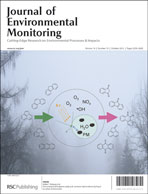Gold mining impact on riverine heavy metal transport in a sparsely monitored region: the upper Lake Baikal Basin case†
Abstract
Mining and ore excavation can cause the acidification and heavy metal pollution of downstream water systems. It can be difficult to assess the load contributions from individual mining areas, which is commonly required for environmental impact assessments. In the current study, we quantified the net impact of the unmonitored mining activities in the Zaamar Goldfield (Mongolia) on heavy metal transport in the downstream Tuul River–Selenga River–Lake Baikal water systems. We also noted that the Zaamar site shares the conditions of limited monitoring with many rapidly developing regions of the world. The heavy metal concentrations and flow data were obtained from historical measurement campaigns, long-term monitoring, and a novel field campaign. The results indicate that natural mass flows of heavy metals in dissolved form increased by an order of magnitude because of mining. Prevailing alkaline conditions in the vicinity of Zaamar can limit the dissolution, maintaining the on-site concentrations below health-risk based guideline values. However, suspended river concentrations are much higher than the dissolved concentrations. The placer gold mining at the Zaamar site has increased the total riverine mass flows of Al, As, Cu, Fe, Mn, Pb and Zn by 44.300, 30.1, 65.7, 47.800, 1.480, 76.0 and 65.0 tonnes per year respectively. We suggest that local to regional transformation and enrichment processes in combination with suspended sediment transport from numerous existing upstream mining areas contribute to high concentrations of dissolved heavy metals in downstream parts of the Selenga River, including its delta area at Lake Baikal. Furthermore, single hydrological events can increase the suspended load concentrations by at least one order of magnitude. Overall, the Selenga River Basin, which drains into Lake Baikal, should be recognised as one of the world's most impacted areas with regard to heavy metal loads, and it contributes to 1% and 3% of the world flux of dissolved Fe and Pb, respectively.


 Please wait while we load your content...
Please wait while we load your content...